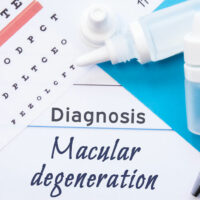Debunking 10 Common Myths About AMD

Age-related macular degeneration (AMD) is a degenerative condition that affects the macula—the small central area of the retina responsible for central vision. The condition is the leading cause of vision loss in those over 50 and is a significant public health issue. Despite its prevalence, there are still many myths and misconceptions about the condition that prevent others from understanding the risks, symptoms, prevention, and management of age-related macular degeneration.
Symptoms
Early signs of AMD include a sudden change in vision, such as more blurriness or distortion than usual. One may also experience difficulty reading fine print or recognizing faces at a close distance. As the disease progresses, one may lose peripheral vision and eventually be unable to see anything beyond 20 feet (6 meters). Other symptoms include loss of eyesight in one or both eyes, change in color perception, and trouble driving or walking at night due to poor visibility at dusk and dawn.
Common myths about AMD
The condition is rare
There are many myths about the disease, but one of the most prevalent one is that the condition is rare. However, millions of people experience some form of age-related macular degeneration, i.e., it affects nearly 1 in 10 people over the age of 50. So if one is experiencing any changes in their vision, they should book an eye consultation immediately.
It leads to total blindness
While age-related macular degeneration can cause vision loss, it does not mean that people affected by the disease will experience a complete loss of vision. AMD often affects the central vision, making it difficult to see things up close.
It cannot be treated
Doctors can recommend a number of treatment options for AMD that help one deal with the symptoms. Treatment may involve wearing custom-made glasses or contact lenses that filter harmful light rays, while other options include laser treatment to remove damaged tissue from the eye. If one is concerned about their vision and believes that they may have signs of AMD, they should consult a doctor and discuss treatment options. Some options can help slow down the progression of the disease and preserve vision.
It is easy to recognize
If one is over 50, they are likely to experience AMD. It is a condition that affects eyesight but can result in subtle vision changes, which might remain undetected. So, it is crucial to get one’s eyes checked by a doctor regularly, especially if one notices minor changes in their vision. Regular eye examinations can help identify the extent of damage and ensure that one receives the treatment necessary to improve their vision.
Carrots can help manage AMD
While carrots may be helpful when it comes to preventing or slowing the progression of AMD, there is no scientific evidence to back up these claims. So, if one is looking for a way to improve their vision health, they should focus on making persistently better food choices and getting essential nutrients from daily meals rather than just carrots.
People with the condition should avoid sun exposure
A common misconception about managing age-related macular degeneration is one should avoid or limit sun exposure. However, there is no evidence to support this claim. So, if one is affected by AMD, they should not let the myth of avoiding sunlight stop them from enjoying the outdoors. One should however wear sunglasses and a hat to protect their eyes from harmful UV rays when out in the sun.
An unhealthy lifestyle has no effect on vision
Some believe that poor lifestyle choices like not exercising, eating junk food, and irregular sleeping patterns do not affect one’s vision. However, this is not true at all. Lifestyle choices play an important role in how the eyes function. So if one wants to maintain a healthy vision for a long time, they should make better lifestyle choices.
Wet AMD is more dangerous than dry AMD
Both forms of age-related macular degeneration are serious concerns and need to be treated with equal emphasis and urgency. Wet AMD develops when fluid accumulates in the eye and can cause vision loss. Dry AMD develops due to thinning of the macula over time.
Dry AMD can be treated more easily
While there is no permanent cure for AMD, common treatments can help slow its progression and improve vision. One treatment option for dry AMD is to take vitamin AREDS 2 antioxidants. These supplements have been shown to reduce the risk of progression to late-stage AMD by 25%.
AMD cannot be prevented
Many people believe that age-related macular degeneration is a natural, inevitable outcome of aging that cannot be prevented. However, this is not true. In fact, the condition can be prevented, slowed down, and managed with early diagnosis and treatment.The prevention calls for recognizing the risk factors that make some people more vulnerable to eyesight issues. The common risk factors include
- High blood pressure
- Excessive exposure to ultraviolet light
- Family history of the disease
- High cholesterol levels
If one believes they are at risk for AMD, they should consider controlling the risk factors and get regular checkups to keep blood pressure and cholesterol levels in check. Additionally, one should opt for a balanced nutritional regimen to maintain optimal vision health and strengthen their eyes. Further, age-related macular degeneration can be diagnosed in several ways—: through an eye exam, with a special camera called an ophthalmoscope that takes pictures of the inner areas of the eyes, or by performing a visual field test that measures how well one can see straight ahead and on either side. If one is diagnosed with AMD, it does not mean they will end up losing their vision entirely. When detected in time, treatment options can help improve the vision and prevent further damage. Additionally, even if one does not have any signs or symptoms of AMD, regular eye examinations can help the doctor determine if one should start considering measures to avoid developing AMD.



